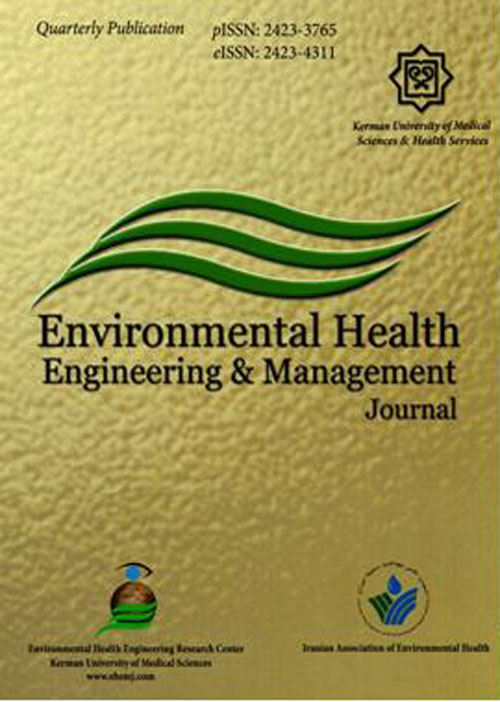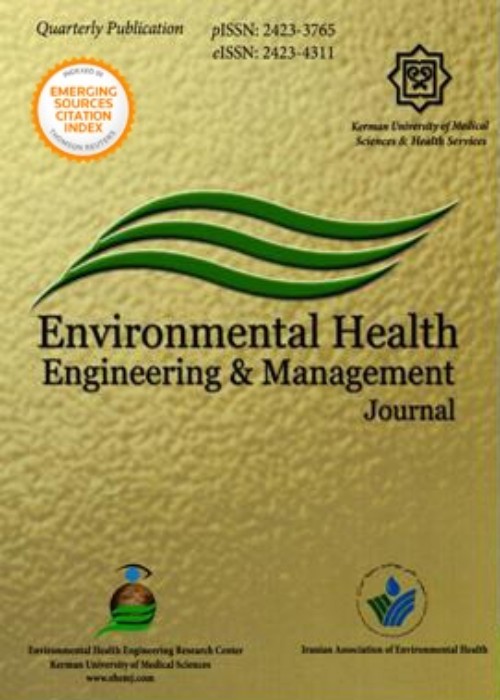فهرست مطالب

Environmental Health Engineering and Management Journal
Volume:5 Issue: 1, Winter 2018
- تاریخ انتشار: 1396/12/28
- تعداد عناوین: 8
-
-
Pages 1-7BackgroundIncreasing nitrate concentrations in groundwater resources is considered a common environmental and public health problem worldwide. In this research, an autotrophic up-flow bioreactor with pumice as media was used to study the effects of the sulfur-to-nitrogen (S/N) ratio and empty bed contact time (EBCT) on nitrate removal efficiency and byproducts.MethodsExperiments were carried out in a 3.47 L up-flow, fixed-bed reactor with 3 sampling ports. To evaluate the overall impact of S/N ratio and EBCT on the performance of the bioreactor, several phases with different S/N ratios and EBCTs were applied.ResultsAt a constant S/N ratio of 3.85 g/g, as EBCT decreased from 24 hours to 2 hours, the nitrate removal efficiency decreased from 98% to 64%. On the other hand, at the desired EBCT of 4 hr, as S/N ratio decreased from 3.85 to 1.51 g/g, nitrate removal efficiency was reduced from 85% to 32%. Changing the EBCT and S/N ratio also affected the effluent nitrite and sulfate concentrations as byproducts. At the S/N ratio of 3.85 g/g and EBCT of 24 hours, effluent nitrite and sulfate concentrations were 0.1 mg NO2--N/L and 463 mg SO4 2-/L, respectively. Decreasing the S/N ratio to 1.51 g/g and the EBCT to 4 hours caused drastic changes in effluent nitrite and sulfate concentrations.ConclusionThe results indicated that the autotrophic denitrification with thiosulfate as electron donor and pumice as media was feasible and applicable for nitrate contaminated groundwater.Keywords: Autotrophic Denitrification, Pumice, Nitrate, Nitrite, Thiosulfate
-
Pages 9-14BackgroundGreenhouse gas (GHG) emissions are increasing worldwide. They have harmful effects on human health, animals, and plants and play a major role in global warming and acid rain.MethodsThis research investigated carbon dioxide (CO2) and CH4 emissions obtained from different parts of the Hakim Farabi, Dobal Khazaei, and Ramin factories which produce ethanol and yeast. Seasonal rates of CO2 at the soil surface at the studied sites were estimated from measurements made on location and at intervals with manual chambers. This study aimed to assess the production rate of GHG emissions (CH4, CO2) in the sugar production units of Hakim Farabi, Dobal Khazaei, and Ramin factories.ResultsMean concentrations of CO2 and CH4 emissions are respectively 279 500.207 and 3087.07 tons/ year from the Hakim Farabi agro-industry, 106 985.24 and 1.14 tons/year at the Dobal Khazaei ethanol producing factory, and 124 766.17 and 1.93 tons/year at the Ramin leavening producing factory.ConclusionSugar plant boilers and the burning of sugarcane contributed the most CO2 and CH4 emissions, respectively. Moreover, lime kilns and diesel generators showed the least carbon dioxide and methane emissions, respectively.Keywords: Carbon Dioxide, Methane, Ethanol, Farms, Global Warming
-
Pages 15-21BackgroundCoagulation is a treatment procedure for metalworking fluids (MWFs). This study aimed to optimize coagulation using four coagulants and compare the results.MethodsIn this research, the outputs of a coagulation procedure in chemical oxygen demand (COD) removal, turbidity, and the release of oil were investigated using four coagulants, ferric chloride (FeCl3), ferric sulfate (Fe2(SO4)3, calcium chloride (CaCl2), and aluminum sulfate (Al2(SO4)3. To optimize the process, a central composite design (CCD) and response surface methodology (RSM) were used.ResultsUnder optimal conditions for using calcium chloride (coagulant concentration 4.2 g/L and pH 3.71), COD and turbidity removals and oil released were respectively 93%, 96.9%, and 31.8 mL. COD and turbidity removals and oil released using aluminum sulfate as a coagulant under optimal conditions (5.36 g/L, pH 4.64) were 75.7%, 89.9%, and 28.9 mL, respectively. With respect to ferric sulfate under optimal conditions (6.25 g/L, pH 3.4), COD and turbidity removals were 60% and 84.1%, respectively and oil released was 16.1 ml. COD and turbidity removals and the greatest amount of oil released by ferric chloride under optimal conditions (3.16 g/L, pH 3.5) were 54.4%, 84.7%, and 15.9 ml, respectively.ConclusionCompared with other coagulants in the treatment of MWFs, calcium chloride achieved the highest removal efficiency in eliminating pollution indicators.Keywords: Wastewater treatment, Metalworking fluids, Response surface methodology, Optimization
-
Pages 23-27BackgroundNoise pollution is one of the most important environmental pollutions that affects human health in different dimensions. The current study aimed to survey the effects of noise pollution on residents of the Samen district in Mashhad.MethodsTo understand the psychological effects that noise pollution caused by vehicles has on people, 400 questionnaires designed to gather demographic data and information on attitudes about noise pollution, its effects on peoples activities, and noise source annoyance were randomly distributed among the people living in the Samen district of Mashhad city. SPSS software was used for statistical analysis.ResultsAccording to the results of this study, the most important effects noise pollution had on the studied society were nervousness (29.1%), conversation problems (19.8%), amnesia (18.3%), and loss of concentration (12.8%). Furthermore, 54.8% of the respondents considered the environmental noises annoying, and 32.5% reported it very annoying. In this study, traffic noise was reported as the most important source of noise pollution.ConclusionGenerally, the results showed that noise pollution is a serious issue in the Samen district, and the necessary actions should be taken to control noise and prevent the effects of noise pollution.Keywords: Noise pollution, Psychological effects, Samen area, Mashhad city
-
Pages 29-37BackgroundBiomedical waste generated from health and health-related activities can be grouped as general waste and hazardous waste. This remains true if and only if there is proper on-site handling, such as the segregation and separation of waste based on the type and nature of the source.MethodsA stratified random sampling design was used to provide representative results for Ethiopia, for various types of facility and management authorities, and for each of the 11 regions. Totally, 1327 health facilities were assessed using the World Health Organization (WHO) inventory tools.ResultsNationally, medical waste in 32.6% of the studied health facilities was stored in covered containers, and in about 27% of them it was stored in another protected environment. About 40% of health facilities stored their medical waste in unprotected areas. Twenty-eight (2.6%) and 420 (39.3%) health facilities used 2-chamber industrial incinerators and 1-chamber drum incinerators, respectively. About 58% of health facilities used unsafe waste treatment methods. The proportion of using safe medical waste disposal method was high in referral hospitals (87.9%). This shows the utilization of safe medical waste disposal methods is in decreasing order from higher to lower levels of organization in health facilities.ConclusionThe present study showed a preliminary finding on the waste disposal systems of health facilities at the national level. Dumping biomedical waste outside the health facility is common, and access to common waste facilities is limited. Therefore, a holistic approach to safe medical waste management practices, including the collection process (handling, sorting, and segregation), storage, treatment and final disposal is crucial in all types of health facilities, regardless of the level of organization, ownership, or geographic distribution.Keywords: Health Facility, Biomedical Waste, Disposal, Incinerator, Ethiopia
-
Pages 39-47BackgroundThe conventional method for managing drinking water quality is not a suitable preventive strategy for protecting public health. A water safety plan (WSP) presents a systematic approach to ensuring the health and quality of drinking water. This study assessed the drinking water supply system safety of Birjand city using the WHOs WSP.MethodsThis investigation employed the WSP-QA Tool and the WSP manual of the WHO and the AWI. For this purpose, software checklists were prepared and, after confirmation of content and face validity, completed based on Birjands water and wastewater company records and interview with companys experts.Data was analyzed using WSP-QA Tool.ResultsFrom total possible 440 points for full use of the program and 328 points of the studied phases, a score of 190 was acquired, indicating a 43.18% coordinated implementation with WSP. System description and management procedures showed the maximum and minimum percentages of congruency with the WSP of 87.5% and 25%, respectively. Among the components of the water supply system, water resource had the most attention.ConclusionAs regards the percentage of overall WSP-phase implementation and the low attention given to some key parameters of the water supply system, such as risk assessment and management procedures, the system currently enjoys a relatively medium level of safety. However, the high points of some phases such as system description, operational monitoring and verification enhance the systems flexibility for changing the current approach of qualitative management to the WSP.Keywords: Drinking water, Safety, Water supply, Risk assessment, Software
-
Pages 49-55BackgroundPhenol is a prevalent pollutant found in many industrial wastewaters, and it is paid singular attention because of its special features like high toxicity, carcinogenic properties, and vital gathering ability that affects the health of humans and the environment. One of the most important technologies for the removal of phenol is the use of adsorbents. The current study investigated the removal of phenol from synthetic aqueous solutions using Citrullus colocynthis seed ash.MethodsThis study is experimental and was conducted on a pilot scale. The efficiency of phenol removal by C. colocynthis seed ash was evaluated in a batch system, and different parameters such as initial concentration of phenol (10, 20, 50, and 80 mg/L), contact time (2, 5, 10, and 30 minutes), pH (2-12), adsorbent dose (0.5, 1, 3, 5, and 10 g/L), and temperature were studied. Excel software was used for data analysis. The adsorption process was modeled with Freundlich and Langmuir isotherms at controlled temperatures.ResultsThe results showed that the highest removal rate of phenol was obtained at a pH of 2 (83.4%), initial phenol concentration of 20 ppm (66.4%), adsorbent dose of 5 g/L (86.8%), and contact time of 10 minutes. The evaluation of correlation coefficients showed that the phenol adsorbed by C. colocynthis seed ash was in greater accordance with the Freundlich model than the Langmuir model.ConclusionIn general, the results of this study revealed that C. colocynthis seed ash has suitable potential for use in removing phenol from aqueous solutions on operation and practical scales due to its low cost and easy access.Keywords: Phenol, Adsorption, Citrullus colocynthis
-
Pages 57-60BackgroundThe quality of life of the citizens is one of the most important issues studied in different countries and used in the planning and monitoring of public policies. The present study measured and evaluated the indicators of quality of urban life among citizens of Mashhad city.MethodsThis analytical study was conducted on 375 citizens of various regions in Mashhad city. The random sampling method using population distribution and short-form questionnaires for data collection were applied. The validity of the questionnaires was verified by experts and the points given each question based on a 5-point Likert scale, and the Cronbach αcoefficient was used to measure the reliability of the questionnaire; the questionnaire rated 0.853%. To analyze the variables under study, SPSS and other statistical methods such as average answers and t test for independent variables were used.ResultsFindings of this research showed that the average health-sanitation dimension and environmental quality dimension are lower than 50% in Mashhad city. Sanitation and health, with a standard deviation of 5.838, are situated below the median level. The most common weakness is related to the dietary intake of protein. Environmental quality with a standard deviation of 5.857 is lower than the median level which is related to garbage separation and landfill sites. This result indicates that the quality of health and the environment in Mashhad is undesirable.ConclusionCitizens satisfaction with quality of life index is lower than average in Mashhad city. Plans for improving the quality of life and developing services are highly necessary for increasing the quality of life.Keywords: Sanitation, Personal satisfaction, Quality of life, Urban healt


